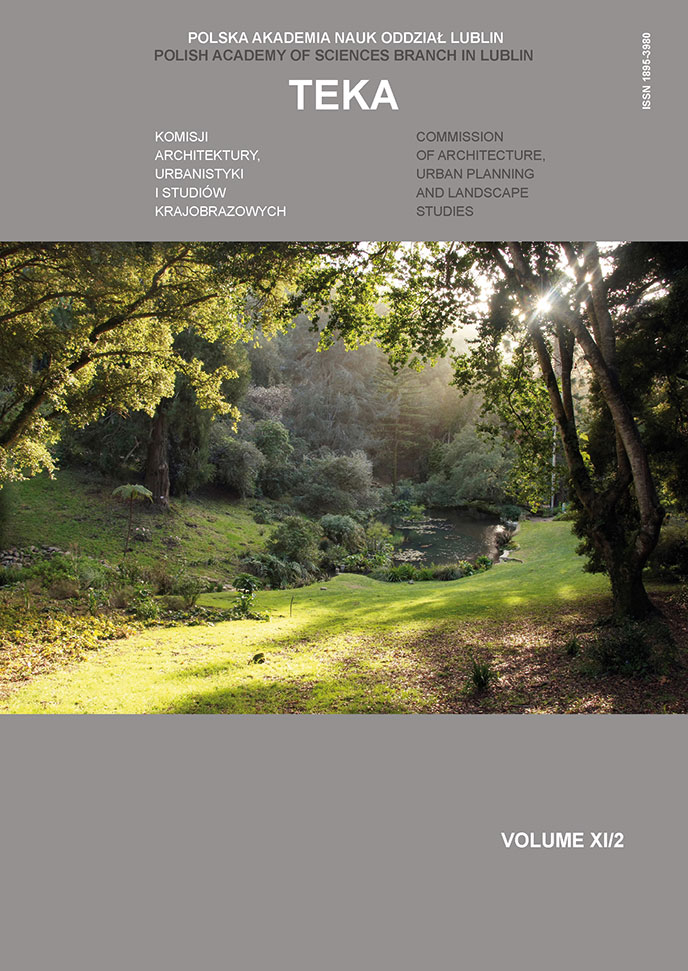Healing gardens as a way of aiding therapy
Article Sidebar
Open full text
Issue Vol. 11 No. 2 (2015)
-
The manor house-park complex in Romanow. The history and current state of preservation
Kamila Lucyna Boguszewska7-14
-
Healing gardens as a way of aiding therapy
Michał Dmitruk15-21
-
Selection of species and crops indoors Polish palaces and mansions in the nineteenth century
Halina Laskowska, Margot Dudkiewicz, Mariusz Szmagara22-32
-
Containers and plants in historic parks and gardens
Halina Laskowska, Margot Dudkiewicz, Paweł Szot33-41
-
Gardens of Islam on the example of garden assumptions in Andalusia
Kamila Lucyna Boguszewska42-51
-
Natural materiality: water as an active element of the gardens by Denis McClair at Volhynia
Petro Rychkov, Nataliya Lushnikova52-62
-
Functional and spatial tansformations and contemporary role of educational garden on the example of school garden in Sobieszyn
Krystyna Pudelska, Kamila Rojek63-72
-
Ground fortifications in the development of the park behind the marine school in Darłowo
Paweł Szumigała, Piotr Urbański, Krzysztof Markowski, Sylwia Sosnowska73-81
Archives
-
Vol. 15 No. 4
2019-12-30 6
-
Vol. 15 No. 3
2019-10-31 9
-
Vol. 15 No. 2
2019-06-28 12
-
Vol. 15 No. 1
2019-03-29 13
-
Vol. 14 No. 3
2018-10-28 14
-
Vol. 14 No. 2
2018-06-29 14
-
Vol. 14 No. 1
2018-03-30 13
-
Vol. 13 No. 4
2017-12-29 8
-
Vol. 13 No. 3
2017-09-29 9
-
Vol. 13 No. 2
2017-06-30 10
-
Vol. 13 No. 1
2017-03-31 10
-
Vol. 12 No. 4
2016-12-30 12
-
Vol. 12 No. 3
2016-09-30 10
-
Vol. 12 No. 2
2016-06-30 9
-
Vol. 12 No. 1
2016-03-31 8
-
Vol. 11 No. 4
2015-12-30 14
-
Vol. 11 No. 3
2015-09-30 7
-
Vol. 11 No. 2
2015-06-30 8
-
Vol. 11 No. 1
2015-03-31 11
Main Article Content
DOI
Authors
Abstract
Being close to nature always had a positive impact on human health and well-being. From the Neolithic Revolution, which began 10,000 years before our era and the start of the transition from hunting and gathering to sedentary life, people began to ascribe mystical powers to sacred gardens, groves or rock formations. In the Middle Ages, gardens were often placed near monasteries. Herbal ones for purely pragmatic, therapeutic function and recreational gardens, as places for contemplation and reverie. With the development of civilization, the presence of gardens amongst the human settlements has become a permanent part of the landscape. Their beneficial effect on the psyche and human health, as well as purely aesthetic qualities has been appreciated. With the development of modern medical techniques, the role of healing gardens has been marginalized, or entirely omitted. In Poland, medical gardens, along with hospitals and clinics are not considered an essential element of their architecture. There is a need for public education, also among architects, to force a trend, focusing on designing healing gardens along with hospital buildings. Health benefits for the patients are disproportionate to the economic costs. Yet health is the most valuable.
Keywords:
References
Cooper M., 1999. Historical and cultural perspective on healing gardens. John Wiley & Sons, Nowy Jork.
Gesler W., 1998. Putting health into place: landscape, identity and well-being, Syracuse, Syracuse University Press.
Hensel W., Tabaczyński S., 1978. Rewolucja neolityczna i jej znaczenie dla rozwoju kultury europejskiej. Zakład Narodowy im. Osolińskich, Wrocław-Warszawa-Kraków-Gdańsk.
Latkowska M.,2008. Hortiterapia – rehabilitacja i terapia przez pracę w ogrodzie. Zeszyty Problemowe Postępów Nauk Rolniczych.
Kaplan S., 1995. The Restorative Benefits of nature: Toward an Integrative framework, Journal of Environmental Psychology. DOI: https://doi.org/10.1016/0272-4944(95)90001-2
Rybczyński W., 1999. A Clearing in the Distance: Frederick Law Olmsted and North America in the Nineteenth Century. Nowy Jork.
Stigsdotter U. i Grahn P., 2002. What makes a garden a healing garden? Journal of Therapeutic Horticulture
Szolginia W., 1992. Architektura: Sigma NOT, Warszawa.


